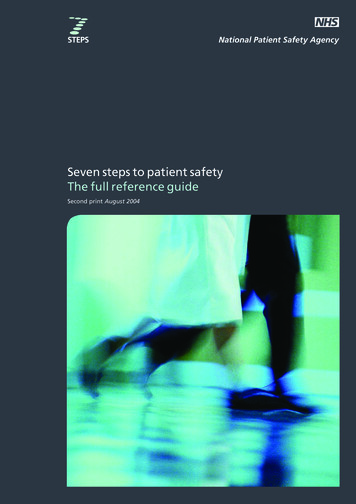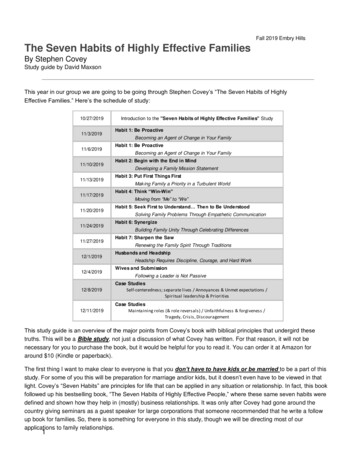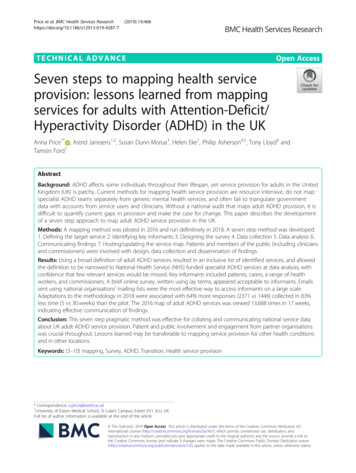
Transcription
Seven steps to patient safetyThe full reference guideSecond print August 2004
Summary introductionEvery day more than a million people are treatedsafely and successfully in the NHS. However, theadvances in technology and knowledge in recentdecades have created an immensely complexhealthcare system. This complexity brings risks, andevidence shows that things will and do go wrong inthe NHS; that patients are sometimes harmed nomatter how dedicated and professional the staff.Your guide to patient safetySeven steps to patient safety describes the steps thatNHS organisations need to take to improve safety.They provide a checklist to help you plan youractivities and measure your performance in patientsafety. Following these steps will help ensure thatthe care you provide is as safe as possible, and thatwhen things do go wrong the right action is taken.They will also help you meet your clinicalgovernance, risk management and controlsassurance targets.The seven steps to patient safetyStep 1 Build a safety cultureStep 2 Lead and support your staffStep 3 Integrate your risk management activityStep 4 Promote reportingStep 5 Involve and communicate with patientsand the publicStep 6 Learn and share safety lessonsStep 7 Implement solutions to prevent harmSeven steps to patient safety is published bythe National Patient Safety Agency (NPSA) and isavailable in full and in summary form atwww.npsa.nhs.uk/sevensteps
National Patient Safety AgencyJuly 2004 Seven steps to patient safetyContentsContents overview1pageA message from the Joint Chief Executive3Introduction9Step 1 Build a safety culture13Step 2 Lead and support your staff35Step 3 Integrate your risk management activity59Step 4 Promote reporting81Step 5 Involve and communicate with patients and the public119Step 6 Learn and share safety lessons141Step 7 Implement solutions to prevent harm169
2Seven steps to patient safetyIntroductionNational Patient Safety AgencyJuly 2004
National Patient Safety AgencyJuly 2004 Seven steps to patient safetyIntroductionA message from theJoint Chief ExecutiveIntroduction3
4Seven steps to patient safetyIntroductionNational Patient Safety AgencyJuly 2004
National Patient Safety AgencyJuly 2004 Seven steps to patient safetyIntroduction5A message from the Joint Chief ExecutiveEvery day more than a million people are treated safely and successfullyin the NHS. However the advances in technology and knowledge inrecent decades have created an immensely complex healthcare system.This complexity brings risks, and evidence shows that things will and dogo wrong in the NHS; that patients are sometimes harmed no matterhow dedicated and professional the staff.The effects of harming a patient are widespread. There can bedevastating emotional and physical consequences for patients andtheir families. For the staff involved too, incidents can be distressing,while members of their clinical teams can become demoralised anddisaffected. Safety incidents also incur costs through litigation andextra treatment.Patient safety concerns everyone in the NHS, whether you work in aclinical or a non-clinical role. At the National Patient Safety Agency(NPSA) we believe that tackling patient safety in the NHS collectivelyand in a systematic way can have a positive impact on the quality ofcare and efficiency of NHS organisations.Your guide to patient safetySeven steps to patient safety describes the steps that NHSorganisations need to take to improve safety. These steps are foundedon a thorough review of literature from across the world (on patientsafety, clinical governance, change management and riskmanagement) and on experience of what works in patient safety. Theguide builds on recommendations made in the Department of Healthpublication An organisation with a memory 1 and replaces the draftguidance ‘Doing Less Harm’2 to reflect current thinking and bestpractice. It also updates NHS organisations on the tools that the NPSAis developing to support the drive towards safer healthcare.The objectives of this guide are to: provide specific information on:- patient safety definitions;- resources such as the safety culture assessment tool, the IncidentDecision Tree (IDT), the introduction to patient safety e-learning toolkitand induction video, and the root cause analysis (RCA) toolkit andproposed training programmes;- guidance on being open with patients and the public;- the National Reporting and Learning System (NRLS);- examples of safety solutions;
6Seven steps to patient safetyIntroductionNational Patient Safety AgencyJuly 2004 provide information on good practice; highlight what the NPSA is doing to help NHS organisations improvepatient safety.It is vital that NHS staff can assess the progress they make towardsdelivering this safety agenda. In this guide we have set out seven stepsthat can be applied at both an organisational and departmental level.They provide a checklist to help you plan your activities and measureyour performance in patient safety. Following these steps will helpensure that the care you provide is as safe as possible, and that whenthings do go wrong the right action is taken. They will also help youmeet your current clinical governance, risk management and controlsassurance targets.Some organisations are already well advanced along the route topatient safety but many are right at the beginning of their journey. Wehave therefore tried to provide practical hints and techniques as well asexamples of local best practice and toolkits for the management ofpatient safety.We have made every effort to pilot each NPSA initiative first. While thismay have slowed our progress we felt that it was crucial before anynational roll out across the NHS. And we have tried not to be tooprescriptive – there are national solutions for universal processes andprocedures but local problems require local solutions tailored to theunique local environment. We hope this guide helps you identify thegains you can make within your own organisation, department or team.Who should read this guide?Seven steps to patient safety is most relevant to staff responsible forclinical governance and risk management, including executive andnon-executive leads. We also encourage all staff who provide care inthe NHS to use it as a patient safety manual. This includes thoseworking in any care setting (primary, secondary and tertiary care, acutecare, ambulance services, mental health services, the independentsector) that provides care for NHS patients. It may also be a helpfulresource for patients, their representatives and the public.The guide is primarily intended for NHS organisations in England andWales but it may also apply to organisations in other countries.
National Patient Safety AgencyJuly 2004 Seven steps to patient safetyIntroduction7AcknowledgmentsThe NPSA recognises that improving patient safety depends not onlyon our work nationally but also on the vital work that is taking place ata local level. We have benefited greatly from the passion and steadfastwork of numerous individuals (staff, patients and the public) across alllevels of the NHS. Since we were established in 2001 we haveencountered a high level of commitment to patient safety from adiverse range of NHS and non-NHS staff. Hundreds of organisationsare already working with us to drive forward the patient safetyagenda.In particular we would like to acknowledge the organisations thathave worked with us to develop and test the NRLS. We would also liketo recognise the organisations that volunteered to pilot our solutionswork and that helped us to develop our patient safety tools. Ourthanks and gratitude go to all these organisations for their time,commitment and enthusiasm for patient safety.Safety in healthcare is a relatively young field internationally and it willbe some time before we understand its full potential. We still have along way to go. But we are already seeing evidence that by workingtogether we can all make healthcare safer.Sue Osborn and Susan WilliamsJoint Chief Executive
8Seven steps to patient safetyIntroductionNational Patient Safety AgencyJuly 2004 Acknowledgments: Authors/editorial support: Suzette Woodward, Susannah Randall, Amanda Hoey and Rachel Bishop Advisors: NPSA staff and Board members, the Department of Health policy advisors, Chief Medical Officers(England and Wales), the National Health Service Litigation Authority, Clinical Risk and Clinical GovernanceStaff in the NHS, Professor J Reason, Professor R Lilford, Professor C Vincent.
National Patient Safety AgencyJuly 2004 Seven steps to patient safetyIntroduction9IntroductionPatient safety – our starting pointIt is important first to explain the rationale for the increased focus onpatient safety in the UK and how this relates to previous safety guidance.The Department of Health publication An organisation with a memorymobilised the patient safety movement in the NHS. The reportreviewed the growing body of international evidence on patient safety.It drew attention to the scale and pattern of potentially avoidablepatient safety incidents a and the devastating consequences these canhave on patients, their families and the healthcare staff involved. Thereport also acknowledged that, as in many other countries, there hasbeen little systematic learning from these patient safety incidents andservice failure in the NHS.It is difficult to accurately estimate the extent of unintended harm topatients across the NHS from the current studies. There is likely to besignificant under-reporting and inadequate documentation of patientsafety incidents within medical records (the usual source ofinformation on unintended harm for most studies).On the best available data in England, extrapolating from a small studyin two acute care trusts based in London, it is estimated that around10% of patients (900,000 using admission rates for 2002/3) admittedto NHS hospitals have experienced a patient safety incident, and thatup to half of these incidents could have been prevented 3. This studyalso estimated that 72,000 of these incidents may contribute to thedeath of patients, although it is unclear what proportion of thisnumber would die as a direct result of the incident*.In the US 4, 5, studies have found that between 44,000 and 98,000incidents are estimated to contribute to patient deaths. This is viewedby many commentators as under-estimating the extent of theproblem. Studies in Australia 6, New Zealand and Denmark1, 7 havesuggested similar findings.The analysis of international evidence in the United States led to twoimportant conclusions 8:1 The potential for error in healthcare systems represents a significant andserious challenge that needs concerted effort to manage.a Patient safety incident: Any unintended or unexpected incident that could have or did lead to harm for one or morepatients receiving NHS-funded healthcare.The terms ‘patient safety incident’ and ‘patient safety incident (prevented)’ will be used to describe ‘adverse events’ /‘clinical errors’ and ‘near misses’ respectively.* Note: the NPSA has revised these figures to reflect increased admission rates.
10Seven steps to patient safetyIntroductionNational Patient Safety AgencyJuly 2004 2 The best way of improving reporting and reducing error rates is totarget the underlying systems failures rather than take action againstindividual members of staff.An organisation with a memory proposed solutions based ondeveloping a culture of openness, reporting and safety consciousnesswithin NHS organisations b. The report identified four key areas thatneed to be addressed if the NHS is to modernise successfully itsapproach to learning from failure:1 Unified mechanisms for reporting, and analysis when things go wrong;2 A more open culture in which incidents or service failures can bereported and discussed;3 Systems and monitoring processes to ensure that where lessons areidentified the necessary changes are put into practice;4 A much wider appreciation of the value of the systems approach inpreventing, analysing and learning from patient safety incidents.In response to An organisation with a memory, the Government reportBuilding a safer NHS for patients 9 described how to implement theserecommendations. It outlined a blueprint for a national incidentreporting system (described in Step 4) and discussed the role of theNational Patient Safety Agency (NPSA).There are many examples of initiatives around the world that havesuccessfully demonstrated that patient safety can be improved.However none has been translated to a whole healthcare system. TheNHS is uniquely placed to pioneer improvements in patient safety acrossa single system and Seven steps to patient safety provides a frameworkfor NHS organisations to achieve this.b NHS organisation: Any area where NHS-funded patients are treated, ie NHS establishments or services; independentestablishments including private healthcare; or the patient's home or workplace. Either all or part of the patients’ care inthese settings is funded by the NHS. This may also be referred to as NHS-funded healthcare.
National Patient Safety AgencyJuly 2004 Seven steps to patient safetyIntroductionThe Seven steps to patient safetyStep 1 Build a safety cultureCreate a culture that is open and fairStep 2 Lead and support your staffEstablish a clear and strong focus on patient safetythroughout your organisationStep 3 Integrate your risk management activityDevelop systems and processes to manage your risks andidentify and assess things that could go wrongStep 4 Promote reportingEnsure your staff can easily report incidents locally andnationallyStep 5 Involve and communicate with patients and thepublicDevelop ways to communicate openly with and listen topatientsStep 6 Learn and share safety lessonsEncourage staff to use root cause analysis to learn howand why incidents happenStep 7 Implement solutions to prevent harmEmbed lessons through changes to practice, processes orsystems11
12Seven steps to patient safetyIntroductionNational Patient Safety AgencyJuly 2004 Bibliography1 Department of Health (2000). An organisation with a memory. London: The Stationery Office. Available at:www.doh.gov.uk/orgmemreport/index.htm (November 2003)2 Department of Health (2001). Draft document: ‘Doing Less Harm’. Previously at www.npsa.nhs.uk Thisdocument is superseded by Seven steps to patient safety and is no longer in circulation.3 Vincent, C, G Neale and M Woloshynowych (2001). ‘Adverse Events in British Hospitals: preliminaryretrospective record review’. British Medical Journal. 322: 517–194 Brennan, TA, LL Leape, NM Laird, L Hebert, AR Localio, AG Lawthers, JP Newhouse, PC Weiler, HH Hiatt(1991). ‘Incidence of adverse events and negligence in hospitalised patients: results of the Harvard MedicalPractice Study I’. New England Journal of Medicine 324(6): 370–65 Leape, LL, TA Brennan, N Laird, AG Lawthers, AR Localio, BA Barnes, L Hebert, JP Newhouse, PC Weiler andH Hiatt (1991). ‘The nature of adverse events in hospitalized patients: results of the Harvard Medical PracticeStudy II’. New England Journal of Medicine 324(6): 377–846 Wilson, RM, WB Runciman, RW Gibberd, BT Harris, L Newby, JD Hamilton (1995). ‘The Quality in AustralianHealthcare Study’. Medical Journal of Australia. 163(9): 458–717 Coles, J. Pryce, D. Shaw, C. (2001). The reporting of adverse clinical incidents – achieving high qualityreporting: The results of a short research study. CASPE research: www.publichealth.bham.ac.uk8 Institute of Medicine (IOM) (2000). To Err is Human: building a safer health system. Washington DC:National Academy Press. Available at www.nap.edu/readingroom (November 2003) and www.iom.edu(November 2003)9 Department of Health (2001). Building a Safer NHS for Patients. Copies can be obtained from theDepartment of Health, PO Box 777 – doh@prolog.uk.com Also available at: www.doh.gov.uk/buildsafenhs(November 2003)
National Patient Safety AgencyJuly 2004 Seven steps to patient safetyStep 1: Build a safety cultureStep 1Build a safety culture13
14Seven steps to patient safetyStep 1: Build a safety cultureNational Patient Safety AgencyJuly 2004
National Patient Safety AgencyJuly 2004 Seven steps to patient safetyStep 1: Build a safety cultureContents15pageBuild a safety cultureThe key principles1717What is a safety culture?Why is a safety culture important?What can health providers do?Safety culture assessment17181920Being open and fairWhy is it important to be open and fair?What can health providers do?222323The systems approach to safetyWhy is the systems approach to safety important?How can the NPSA help?Organisational safety culture assessment toolCreating the virtuous circle: patient safety, accountabilityand an open and fair cultureIncident Decision Tree (IDT)242828282829Good practice in building a safety culture32Bibliography33
16Seven steps to patient safetyStep 1: Build a safety cultureNational Patient Safety AgencyJuly 2004
National Patient Safety AgencyJuly 2004 Seven steps to patient safetyStep 1: Build a safety culture17Step 1Build a safety cultureImproving patient safety c in the UK requires change in many differentareas, including a change in the culture within the NHS. Evidence fromother industries shows that if the culture of an organisation is safetyconscious and people are encouraged to speak up about mistakes,then safety is improved 1 2 3.In this first Step we focus on changing the culture of the NHS to improvesafety for patients. We explain what the NPSA means by a ‘safety culture’,which includes being open and fair and subsequently the systemsapproach to safety. We identify how NHS organisations can assess andchange their current culture, and how the NPSA can provide support inbuilding a safety culture in healthcare at national and local level.The key principlesA safety culture is where staff within an organisation have aconstant and active awareness of the potential for things to gowrong. Both the staff and the organisation are able toacknowledge mistakes, learn from them, and take action to putthings right.Being open and fair means sharing information openly and freely,and fair treatment for staff when an incident happens. This is vitalfor both the safety of patients and the well-being of those whoprovide their care.The systems approach to safety acknowledges that the causes ofa patient safety incident cannot simply be linked to the actions ofthe individual healthcare staff involved. All incidents are alsolinked to the system in which the individuals were working.Looking at what was wrong in the system helps organisations tolearn lessons that can prevent the incident recurring.What is a safety culture?The culture of an organisation is the pattern of beliefs, values,attitudes, norms, unspoken assumptions and entrenched processesthat shape how people behave and work together. It is a very powerfulc Patient safety: The process by which an organisation makes patient care safer. This should involve: risk assessment; theidentification and management of patient-related risks; the reporting and analysis of incidents; and the capacity to learnfrom and follow-up on incidents and implement solutions to minimise the risk of them recurring.
18Seven steps to patient safetyStep 1: Build a safety cultureNational Patient Safety AgencyJuly 2004 force and something that remains even when teams change andindividual staff move on.There isn’t a universally accepted definition of a safety culture inhealthcare 4 but it is essentially a culture where staff have a constantand active awareness of the potential for things to go wrong. It is alsoa culture that is open and fair and one that encourages people tospeak up about mistakes. In organisations with a safety culturepeople are able to learn about what is going wrong and then putthings right 5.In these organisations patient safety is at the forefront of everyone’s mindsnot only when delivering healthcare but also when setting objectives,developing processes and procedures, purchasing new products andequipment, and redesigning clinics, wards, departments and hospitals. Itinfluences the overall vision, mission and goals of an organisation.Why is a safety culture important?There is evidence that when open reporting and even-handedanalysis of what went wrong are encouraged in principle and byexample, this can have a positive and quantifiable impact on theperformance of an organisation 6.A safety culture will help NHS organisations to achieveimprovements within their clinical governance d agenda. A key partof achieving good clinical governance is recognising that it is notalways possible to achieve the perfect outcome clinically and thatlessons learned are an important and integral part of a continuousprogramme for quality improvement 7.A safe organisation is also an informed organisation 3. The key benefit ofthis for the NHS is that each organisation is aware of what can go wrongand what has gone wrong. And as more errors and incidents are reportedon a regular basis, each organisation can analyse them according to avariety of factors. If the analysis demonstrates significant themes andclusters of incidents in relation to specific factors, limited resources canthen be targeted at the areas that require further investigation.Other important benefits of a safety culture in the NHS are: a potential reduction in the recurrence and in the severity of patient safetyincidents through increased reporting and organisational learning; a reduction in the physical and psychological harm patients can sufferd Clinical governance: A framework through which NHS organisations are accountable for continuously improving thequality of their services and safeguarding high standards of care by creating an environment in which excellence in clinicalcare will flourish.
National Patient Safety AgencyJuly 2004 Seven steps to patient safetyStep 1: Build a safety culture19because people are more aware of patient safety concepts, are workingto prevent errors and are speaking up when things go wrong; a lower number of staff suffering from distress, guilt, shame, loss ofconfidence and loss of morale because fewer incidents are occurring; an improvement in waiting times for treatment through a higherturnover of patients. This is because patients who experience a safetyincident require, on average, an extra seven to eight days in hospitalover and above the time their treatment would normally require 6; a reduction in the costs incurred for treatment and extra therapy 8 9 10 ; a reduction in resources required for managing complaints and claims; a decrease in wider financial and social costs incurred through patientsafety incidents including lost work time and disability benefits.What can health providers do?Changing values, beliefs and attitudes is not easy 11. Developing asafety culture in an organisation needs strong leadership and carefulplanning and monitoring. It also requires changes at all levels of theNHS. It is vital that not only clinical staff but all those who work in NHSorganisations, as well as patients and carers, ask themselves how theycan help to improve the safety of patients.Seven steps to patient safety describes in practical terms what NHSorganisations need to do to build a safety culture. Each Step explainshow to implement specific actions, as outlined below:Step 1 Promote a safety culture that is open and fair for sharinginformation and ensuring lessons are learnedStep 2 Demonstrate that patient safety is a top leadership priorityand fostering effective teamworkStep 3 Implement integrated risk management processes androutinely conduct organisation-wide assessments of therisk of error and incidents. Evaluate clinical care,procedures, processes and the working environmentStep 4 Report patient safety incidents and identify trends.Give recognition for reporting incidents and safety-drivendecision-making
20Seven steps to patient safetyStep 1: Build a safety cultureNational Patient Safety AgencyJuly 2004 Step 5 Engage patients and families in their safety and providingfeedbackStep 6 Undertake systematic investigations following incidentsto guide continuous learning and system improvements 3Step 7 Implement patient safety improvements that avoidreliance on memory and vigilanceSafety culture assessmentThe first stage in developing a safety culture is to establish the cultureof your organisation at present. A number of tools are already availableto help determine underlying beliefs, attitudes and behaviour. Mostare in the form of checklists or questionnaires for staff to complete.They address a variety of issues, including: senior management visibility and commitment to safety; communication between staff and managers; attitudes to incident reporting, blame and punishment; factors in the work environment that influence performance (forexample, fatigue, distractions, equipment design or usability).When choosing a tool to assess safety culture it is important to be awarethat it will provide a snapshot of the culture at one point in time, and youneed to repeat the assessment regularly to check your progress.To give organisations a sense of how a safety culture assessmentworks, some examples of the tools available are explained below. Theyfall broadly into two types:
National Patient Safety AgencyJuly 2004 Seven steps to patient safetyStep 1: Build a safety culture21Typological toolsDimensional toolsThese are checklists of the features anorganisation with a safety culture shouldexhibit. They allow staff to assess whetherthe safety features exist in their organisationor not. Typological tools provide a singlestatement on the organisation’s safetyculture ranging from ‘unsafe’ to ‘very safe’.These define an organisation by its positionon a number of continuous variables. Data isusually collected by using a scale (i.e. a 1–5response scale) in which staff rate how farthey agree or disagree with a set ofstatements.Checklist for Assessing InstitutionalResilience (CAIR ) 12Safety Attitudes Questionnaire(SAQ) 18 19The checklist comprises 20 points based ona variety of research evidence 13 14 15 16 17 .The SAQ was designed to study the attitudesof pilots in the cockpit and used as a baselinefor assessing the effects of airline industrytraining programmes. It was tailored for usein healthcare in the late 1990s by ProfessorRobert Helmreich e as the Operating Roomor Operating Theatre ManagementAttitudes Questionnaire (ORMAQ andOTMAQ respectively). The questionnairecompares attitudes to safety acrossprofessional groups and between hospitals.Manchester Patient Safety AssessmentTool 20 (MaPSaT)Stanford Patient Safety Centre ofInquiry Culture Survey 22Resulting from collaboration between theNational Primary Care Research andDevelopment Centre and ManchesterUniversity’s psychology department, andbased on Westrum’s 21 theory oforganisational safety, MaPSaT aims to helpstaff in primary care trusts measure thesafety culture in their organisation.The Stanford Survey collects data on 16topics important to a culture of safety inhealthcare, including: whether reporting incidents is rewardedor punished; senior management commitment andattitude towards patient safety; how risks are perceived among differentstaff; how safety data is handled; time pressures on staff; whether staff stick to policies andprocedures; how well safety is resourced and thetraining staff received; the quality of communication in the team.Advancing Health in America (AHA) andVeterans Health Association (VHA):Strategies for Leadership. An Organisational Approach to Patient Safety 23This checklist helps organisations assesswhich areas of its practice promote apatient safety culture and which areas itneeds to improve on.e Professor of psychology at the University of Texas, Austin and director of a research project funded by the Federal AviationAdministration to study human error and develop strategies to manage it
22Seven steps to patient safetyStep 1: Build a safety cultureNational Patient Safety AgencyJuly 2004 Details of the NPSA safety culture assessment tool can be found in thesection ‘How can the NPSA help?’ further in this Step.Being open and fairA fundamental part of any organisation with a culture of safety is toensure that is it open and fair. For NHS organisations this means that: staff are open about incidents they have been involved in; staff and organisations are accountable for their actions; staff feel able to talk to their colleagues and superiors about any incident; NHS organisations are open with patients, the public and staff whenthings have gone wrong, and explain what lessons will be learned; staff are treated fairly and supported when an incident happens.The Department of Health’s publication, An organisation with amemory 5 highlighted how in the past the NHS has operated in aculture of blame rather than promoting openness. When things wentwrong the response was often to seek one or two frontline workers toblame, who may then have faced disciplinary measures or professionalcensure 24 and media attention. The National Audit Office report onsuspensions of clinical staff 25 following patient safety incidents alsofound that several staff were suspended despite evidence of systemicfailures rather than individual shortcomings.The Kennedy Report f recommended that every effort should be madeto create an open and non-punitive environment in the NHS in which itis safe to report and admit incidents. The Government has since made itclear that being open and fair must become a top priority in healthcare.To create an open and fair environment we need to dispel twokey myths 26: The perfection myth: if people try hard enough, they will not makeany errors. The punishment myth: if we punish people when they make errors,they will make fewer of them; that remedial and disciplinary action willlead to improvement
Seven steps to patient safety describes the steps that NHS organisations need to take to improve safety. These steps are founded on a thorough review of literature from across the world (on patient safety,clinical governance, change management and risk managemen










